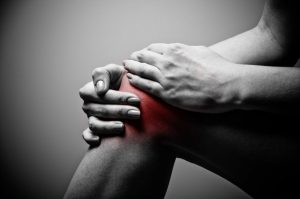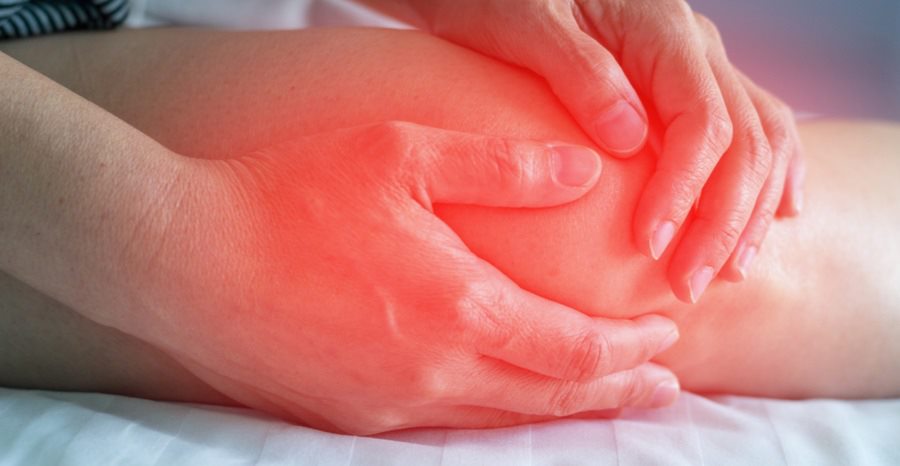Patellofemoral pain syndrome goes by many different names. It describes the condition in which the front of your knee is painful, especially in the kneecap area. Also referred to as runner’s knee, patella, or jumper’s knee.
If your knee were to suffer an injury or trauma and it ended up damaging the joint or its cartilage, this could cause you to get Patellofemoral Pain Syndrome. Physically active people, such as athletes, often get this syndrome because they are more likely to fall and bang their kneecap on hard surfaces. But the condition can still happen to just about anyone under the right circumstances. In some cases, a person might have a kneecap that moves abnormally from the femur bone. This can put a lot of pressure on the kneecap’s upper cartilage as well as on the trochlear surface, which is where the two facets of the femur rub together.
The symptoms that you will feel from Patellofemoral Pain Syndrome could be anything from minor discomfort to extreme pain. Home treatment is often recommended for this condition. Sometimes conservative treatments like rest are all you need to alleviate the pain and discomfort.
Symptoms
 The most common symptom that you will feel from having Patellofemoral Pain Syndrome is pain in the front knee area. It is usually an aching feeling in either one or two of your knees. If you perform physical activity, the pain will only get worse.
The most common symptom that you will feel from having Patellofemoral Pain Syndrome is pain in the front knee area. It is usually an aching feeling in either one or two of your knees. If you perform physical activity, the pain will only get worse.
Other symptoms of the Patellofemoral Pain Syndrome are as follows:
- Exercise pain
- Knee bending pain when performing activities like jumping, squatting, or walking up stairs.
- Knee bending pain while sitting for too long. This can happen when sitting at the computer or watching television.
- The knee has popping or cracking noises coming from it as you walk up the stairs or stand up after sitting for too long.
If your knee joint locks, that doesn’t mean you have Patellofemoral Pain Syndrome. Locking knee joints occurs from a different kind of injury, like a meniscal tear.
Diagnosing the Condition

A doctor must perform a physical exam on you before they can diagnose you with having Patellofemoral Pain Syndrome . You will be asked questions about your pain, such as what makes it feel better or worse. The doctor will check to see if your kneecap looks to be unstable. They will have you perform various range-of-motion exercises for them.
Doctors can usually determine whether a patient has Patellofemoral Pain Syndrome by a simple physical exam. They don’t usually need to have imaging studies done. However, an X-ray might be performed just to make sure that another injury isn’t causing the symptoms.
Home Treatments For Patellofemoral Pain Syndrome
Most people get Patellofemoral Pain Syndrome because of overactivity or overtraining. That is why resting will usually cause the joint to fix itself and treat the problem. Here are some other treatment options to assist in the healing process:
- There is something called the “RICE method” which is popular to do. This consists of Rest, Ice, Compression, and Elevation. Take an elastic bandage and wrap your knee with it. Either that or you can apply a pull-on bandage which has a special cut out for the knee area. Most drugstores sell these types of bandages.
- Apply a topical pain relief cream and massage it into the joint and muscles surrounding the knee.
- Take an anti-inflammatory drug such as Ibuprofen that is non-steroidal.
- Use orthotics. These are unique shoe inserts which add stability to your ankles and feet as you walk. You can also buy these items at most drugstores. Sometimes your doctor may have one custom-made for you as part of their prescription.
- Have a sports massage done to relax your tense muscles, especially if they’re causing you pain.
If you want to prevent these pains from occurring in the future, you will have to change your regular activities so that you do not put too much stress on the knees. Any high-intensity activities like weightlifting, football, or running need to be reconsidered. Try replacing them with low-intensity exercises, such as bicycling, swimming, or walking. Also, stretch before your exercises and put on any supportive inserts or footwear that you have.
Exercises That Will Lower Your Risk of Pain Patellofemoral Pain Syndrome
There are muscles of the leg which help support the knee. Below is a list of exercises which will stretch these muscles as well as strengthen them. If you perform these exercises regularly, it will assist in reducing the pain that you feel from the Patellofemoral Pain Syndrome . You should also stretch your hamstrings and calf muscles too so that you can lower the tension which causes pain as well.
Leg Extensions
The front of the upper thigh area is where your quadriceps muscles are located. Leg extensions can help strengthen them.
- Sit down in a chair. Keep your feet down flat on the floor.
- Extend your right leg straight. Your upper thigh muscles should feel worked. Keep your leg straight in this position for 5 seconds. Put your foot back down on the floor. Do these steps 10 additional times.
- Now do the same process on your left leg. Once you are done, rest both legs for up to 30 seconds. Go back to your right leg and repeat the exercises, and then go to your left. Rest and repeat on both legs an additional time.
Stretch Your Quadriceps
Once you are done with your leg extension exercises, it is time to stretch your quadriceps which have just been worked out.
- Stand straight. Rest your left hand on a piece of furniture or anything that is strong.
- Raise your right foot and then grab the top of it with your right hand. Pull it back toward your buttocks. Your right knee should be pointed directly at the floor below. Keep pulling so that the front of your leg feels stretched. Stay in this position for up to 30 seconds.
- Now do the same thing with your left leg. Repeat this process on both legs about 3 to 5 more times.
Medical Treatments Patellofemoral Pain Syndrome
If you take home treatments for your Patellofemoral Pain Syndrome , but they have no effect, then your doctor is probably going to recommend that you get surgery. The following are the typical surgical intervention procedures which may be done on people with Patellofemoral Pain Syndrome :
Arthroscopy – The surgeon places a camera inside the knee joint and then removes the cartilage that is damaged. If the tendons are tight, the surgeon may release them and place more pull on the patient’s kneecap. That way, it can move around properly in the groove.
Tibial Tubercle Transfer – The doctor will perform a kneecap realignment procedure on the patient. This is where the tibial tubercle and patellar tendon are moved to enhance the alignment of the knee. The former is the bony area of the leg’s shinbone. These surgical treatments are not usually needed. But they are reserved for people who have developed unbearable pain from this condition which cannot be alleviated from conventional forms of treatment. If this describes your current situation, talk with your doctor about your surgical options.
Conclusion
For most people suffering from the Patellofemoral Pain Syndrome , they can reduce their painful symptoms by simply altering their home treatment and exercise training regimen. Older sufferers might find it more difficult to alleviate the pain. If both kneecaps experience pain, then it will be difficult to treat that as well.
Other factors which affect the recovery process of Patellofemoral Pain Syndrome include the seriousness of the trauma or injury endured. The Hospital for Special Surgery in New York has stated that if you dislocate your kneecap and develop Patellofemoral Pain Syndrome from it as a result, then the recovery process could take up to 5 months.

